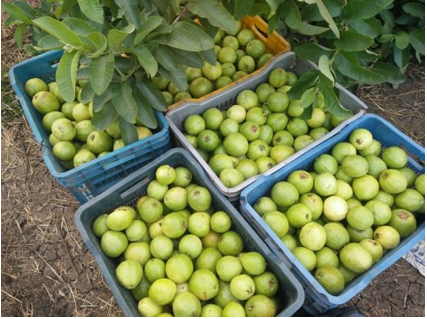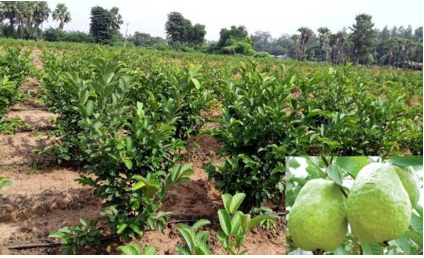آئی این پی ویلتھ پی کے
Azeem Ahmed Khan
A progressive farmer in southern Punjab is revolutionizing guava cultivation by adopting high-density farming combined with solar-powered drip irrigation, dramatically boosting yield, reducing costs, and conserving water, reports WealthPK.

Khursheed Ahmed Khan Khattak is the first grower in Pakistan to pioneer high-density guava farming. His orchard in Mian Channu Tehsil of Khanewal District stands as a model of modern, efficient, and profitable agriculture. “I received 280 maunds per acre yield after just one year,” he told WealthPK. “That kind of production is unthinkable in traditional farming, where even trees take 7 to 8 years to mature.”
In traditional guava farming, only 70 to 80 trees are planted per acre; in contrast, high-density planting allows up to 2,000 trees per acre, he said. Khursheed has optimized his 6.75-acre farm with 12,200 China Gola guava plants, spaced 3 feet apart plant-to-plant and 9 feet line-to-line, with a 12-foot service road after every fifth row to ease access and harvesting.
“It is easy to manage; the labour can move between rows easily, pruning trees and harvesting fruit efficiently,” he explained. The compact trees, kept below 6 feet in height through regular pruning, begin fruiting within 15 months of planting. The variety Khursheed grows, China Gola, is known for its productivity and quality. “The more you prune it, the more it fruits.
The size is exceptional, up to 622 grams per fruit,” he said. Central to Khursheed’s success is the solar-powered drip irrigation system, heavily subsidized by the government in 2017, the year of his take-off. The Rs1.97 million project was funded 80% for solar and 60% for drip irrigation, with Khursheed paying only Rs560,000 from his pocket.
“Drip irrigation is far better than flood irrigation because it delivers water and nutrients right to the roots,” he said. “The soil stays lightly moist all the time, and the plant keeps feeding itself, something that does not happen with flood irrigation.” He emphasized that fertilizer usage drops sharply with drip irrigation. “In two years, I used only 16 bags of fertilizer across my 6.75 acres of land. Normally, hundreds of bags would be needed,” he added.
Additionally, drip irrigation reduces weed growth, maintains fruit quality, and conserves water. “From 1 acre, you can get up to 250-280 maunds per year, twice a year. Even if market rates vary, the income potential is unmatched compared to traditional methods,” he said. Unlike large, tall trees in conventional guava orchards, Khursheed’s guava plants are small in size, much like cotton, making harvesting easier and reducing the labour costs.

Despite his success, Khursheed admitted that many farmers remained skeptical. “They think small trees cannot give high yields, but I have shown it is possible and profitable,” he said. He has urged guava growers across the country to adopt high-density plantations with drip systems.
Khursheed said his system not only improved yields but also aligned with climate-smart agriculture goals by conserving water, reducing chemical fertilizer use, and minimizing soil degradation. “There are no herbicides in my garden,” he said, adding, “Clean farming is the future.” His nursery now supplies China Gola plants to the farmers nationwide, with home delivery options for those looking to replicate his success.
With more farmers like Khursheed leading the way, Pakistan’s guava industry is poised for transformation. The combination of high-density planting and drip irrigation could be the breakthrough the sector needs to increase exports, boost rural incomes, and adapt to climate challenges.
Credit: INP-WealthPk




